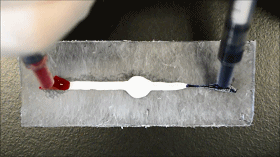澳大利亚国立大学的科研人员最近发布了一种智能材料,遇水材料迅速卷曲成吸管并能快速将水从管子一端传送至另外一端。当卷曲的管子遇到乙醇时,管子又将展开回到原状。

这种奇特的材料上层是聚己内酯PCL材料,下层由聚氯乙烯PVC微纤构成,PCL具有亲水性遇水负责材料自组装卷曲,而下层PVC具有疏水性可以防止水滴流失。据介绍,这种奇特的材料有望应用在生物传感器和微型机器人系统等领域中。

参考文献:Mimosa Origami: A nanostructure-enabled directional self-organization regime of materials,Science Advances 24 Jun 2016: Vol. 2, no. 6, e1600417,DOI: 10.1126/sciadv.1600417
以下是anu的报道:
Scientists make a self-folding straw | ANU
Scientists at The Australian National University (ANU) have made a new material which folds itself into a straw-like tube when it comes into contact with water, and then propels the liquid through the tube.
The new material can be used to easily create cheap fluid distribution systems that could be used for medical sample analysis, biological sensors or micro-robotics.
Lead researchers William Wong and Associate Professor Antonio Tricoli said the paper-like material can respond to a small water droplet by folding in a tube several centimetres long. The water then moves through the tube.
“If we place a drop of water at one end, the material will curl into a tube, delivering the liquid up to 15 centimetres away,” said Mr Wong, from the ANU Research School of Engineering.
“This enables a rapid self-assembly of complex shapes, such as bent, curved and splitting channels, that are a building block for micro-fluidic systems.”
Previous studies have harnessed surface tension to fold materials into origami shapes such as tiny cubes or pyramids, but this is the first to use the effect for a tube of several centimetres.
The team at the Nanotechnology Research Laboratory of the Research School of Engineering found that the channelled water could even navigate challenging shapes such as T-intersections, forks and curves.
The ability to control and direct the flow of tiny amounts of liquid will be useful where there are inherent dangers to humans, such as highly reactive environments or with bio sensors of infectious diseases.
The material is cheap and the manufacturing process is non-toxic and will scale well to industrial levels.
Co-researcher Dr Dave Nisbet, from the ANU Research School of Engineering, said the material was also compatible with living tissue.
“Because it is safe this could be used for cheap sensors to diagnose cancer and other diseases. It will be really important for biology,” Dr Nisbet said.
The material is made of two thin layers of nanofibres sandwiched together. The top functional layer, made of polycaprolactone nanofibres, is the water-responsive energy-dense component (superhydrophilic), which draws the material up around the water droplet.
The bottom layer is made of microfibres of polyvinylchloride (PVC) which is strongly water repellent (superhydrophobic) and prevents the water from escaping once the material has rolled into a tube.
Associate Professor Tricoli, the research group leader, said the folding motion could also be used to move limbs that are attached, similar to the way the fronds of the Asian Mimosa plant close up when touched.
“We can make the material roll up with water, and then unroll again by adding ethanol. This gives us chemically activated movement, that could be really useful in biological sensors and actuators,” Associate Professor Tricoli said.